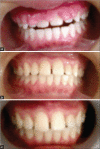Orofacial granulomatosis: A case report with review of literature
- PMID: 23162350
- PMCID: PMC3498725
- DOI: 10.4103/0972-124X.100934
Orofacial granulomatosis: A case report with review of literature
Abstract
Orofacial granulomatosis (OFG) encompasses conditions characterized by non-necrotizing granulomatous inflammation of the oral and maxillofacial region that present clinically as labial enlargement, perioral and/or mucosal swelling, oral ulcerations, and gingivitis. The unifying term "OFG" has been introduced to integrate the spectrum of various disorders, including Melkersson-Rosenthal syndrome and granulomatous cheilitis (which is sometimes considered to be a monosymptomatic form of Melkersson-Rosenthal syndrome), and has been shown to be associated with Crohn's disease, sarcoidosis, and infectious diseases such as tuberculosis. Although various etiological agents such as food substances, food additives, dental materials, and various microbiological agents have been implicated in the disease process, its precise pathogenesis is yet to be elucidated. Delayed type of hypersensitivity reaction appears to play a significant role, although the exact antigen inducing the immunological reaction varies in individual patients. However, evidence for the role of genetic predisposition to the disease is sparse. The underlying immunological mechanism appears to show some similarities between OFG and Crohn's disease, emphasizing the need for more comparative studies of the two entities. The aim of this article is to report a case of OFG, along with a detailed literature review of the facts and variations associated with its nomenclature, clinical presentation, and etiology. It also projects the challenges that a professional has to face in the diagnosis and treatment planning of such cases.
Keywords: Crohn's disease; Melkersson–Rosenthal syndromgranulomatosis; orofacial granulomatosis.
Conflict of interest statement
Figures
Similar articles
-
Orofacial granulomatosis: clinical signs of different pathologies.Med Princ Pract. 2015;24(2):117-22. doi: 10.1159/000369810. Epub 2015 Jan 9. Med Princ Pract. 2015. PMID: 25592641 Free PMC article. Review.
-
Orofacial granulomatosis: review on aetiology and pathogenesis.J Oral Pathol Med. 2008 Apr;37(4):191-5. doi: 10.1111/j.1600-0714.2007.00591.x. J Oral Pathol Med. 2008. PMID: 18321344 Review.
-
Orofacial granulomatosis presenting as bilateral eyelid swelling.Saudi J Ophthalmol. 2012 Apr;26(2):177-9. doi: 10.1016/j.sjopt.2012.02.009. Epub 2012 Mar 3. Saudi J Ophthalmol. 2012. PMID: 23960989 Free PMC article.
-
Orofacial Granulomatosis.Dermatol Clin. 2015 Jul;33(3):433-46. doi: 10.1016/j.det.2015.03.008. Epub 2015 May 6. Dermatol Clin. 2015. PMID: 26143423 Review.
-
Melkersson-Rosenthal syndrome and orofacial granulomatosis.Dermatol Clin. 1996 Apr;14(2):371-9. doi: 10.1016/s0733-8635(05)70363-6. Dermatol Clin. 1996. PMID: 8725591 Review.
Cited by
-
Orofacial Granulomatosis in Children can be the Initial Manifestation of Systemic Disease: A Presentation of Two Cases.Dermatol Reports. 2014 May 12;6(1):5039. doi: 10.4081/dr.2014.5039. eCollection 2014 Feb 17. Dermatol Reports. 2014. PMID: 25386323 Free PMC article.
-
Orofacial granulomatosis: A case report and a proposal of a diagnostic algorithm for oral granulomatous lesions.J Oral Maxillofac Pathol. 2021 May-Aug;25(2):346-350. doi: 10.4103/0973-029X.325238. Epub 2021 Aug 31. J Oral Maxillofac Pathol. 2021. PMID: 34703131 Free PMC article.
-
Recurrent lip swelling: a diagnostic challenge.BMJ Case Rep. 2014 Aug 21;2014:bcr2013203018. doi: 10.1136/bcr-2013-203018. BMJ Case Rep. 2014. PMID: 25188924 Free PMC article.
-
Association between orofacial granulomatosis and Crohn's disease in children: systematic review.World J Gastroenterol. 2014 Jun 21;20(23):7497-504. doi: 10.3748/wjg.v20.i23.7497. World J Gastroenterol. 2014. PMID: 24966621 Free PMC article.
-
Orofacial granulomatosis: clinical signs of different pathologies.Med Princ Pract. 2015;24(2):117-22. doi: 10.1159/000369810. Epub 2015 Jan 9. Med Princ Pract. 2015. PMID: 25592641 Free PMC article. Review.
References
-
- Alawi F. Granulomatous diseases of the oral tissues: differential diagnosis and update. Dent Clin North Am. 2005;49:203–21. - PubMed
-
- Patton DW, Ferguson MM, Forsyth A, James J. Oro-facial granulomatosis: A possible allergic basis. Br J Oral Maxillofac Surg. 1985;23:235–42. - PubMed
-
- Pachor ML, Urbani G, Cortina P, Lunardi C, Nicolis F, Peroli P, et al. Is the Melkersson-Rosenthal syndrome related to the exposure to food additives?. A case report. Oral Surg Oral Med Oral Pathol. 1989;67:393–5. - PubMed
-
- Carr RD. Is the Melkersson-Rosenthal syndrome hereditary? Arch Dermatol. 1966;93:426–7. - PubMed
-
- Meisel-Stosiek M, Hornstein OP, Stosiek N. Family study on Melkersson-Rosenthal syndrome.Some hereditary aspects of the disease and review of literature. Acta Derm Venereol. 1990;70:221–6. - PubMed



